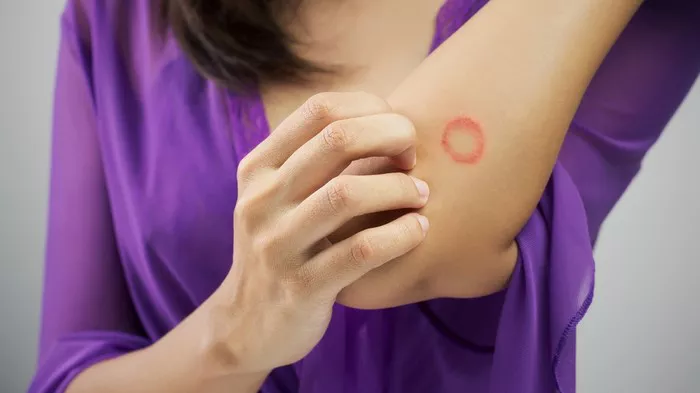Understanding Ringworm: The Culprit and Its Manifestations
Before delving into its contagious nature, let’s grasp the basics of ringworm. Dermatophytes thrive on keratin, a protein found in the outer layer of the skin, hair, and nails. When these fungi infect these tissues, they lead to the characteristic symptoms associated with ringworm.
1. Skin Ringworm (Tinea Corporis): This form of ringworm presents as red, scaly patches with defined borders, often in a ring-like shape. It can occur on any part of the body, excluding the scalp, beard area, and groin.
2. Scalp Ringworm (Tinea Capitis): Primarily affecting children, scalp ringworm manifests as round, scaly patches on the scalp, often accompanied by hair loss or broken hairs.
3. Groin Ringworm (Tinea Cruris): Commonly known as jock itch, this form affects the groin area, presenting with redness, itching, and a distinct edge.
4. Nail Ringworm (Tinea Unguium): Nail ringworm affects the fingernails or toenails, causing them to become thickened, discolored, and brittle.
Contagiousness of Ringworm: Understanding Transmission Dynamics
Ringworm is indeed contagious, primarily through direct contact with an infected person, animal, or contaminated objects. Here’s how transmission occurs:
1. Human-to-Human Transmission:
Direct skin-to-skin contact with an infected individual can transfer the fungal spores responsible for ringworm. This can happen through activities such as shaking hands, sharing personal items like clothing or towels, or engaging in contact sports where there is close bodily contact.
2. Animal-to-Human Transmission:
Pets, particularly cats and dogs, can carry dermatophytes and pass them on to humans. Close contact with infected animals, petting, or sharing bedding with them can facilitate transmission. It’s important to note that not all animals with ringworm show visible symptoms, making detection challenging.
3. Object-to-Human Transmission:
Fungal spores shed by infected individuals or animals can contaminate objects such as combs, brushes, clothing, and bedding. Coming into contact with these contaminated objects can transfer the spores to a new host, facilitating infection.
Risk Factors for Contracting Ringworm
While anyone can contract ringworm, certain factors increase the likelihood of infection:
1. Direct Contact: Individuals who regularly come into close contact with infected individuals or animals are at higher risk.
2. Poor Hygiene: Inadequate hygiene practices, such as infrequent handwashing or sharing unwashed clothing, can increase the risk of ringworm transmission.
3. Warm, Humid Environments: Dermatophytes thrive in warm, moist environments. Therefore, individuals living in tropical or subtropical regions may be more susceptible to ringworm infections.
4. Compromised Immune System: People with weakened immune systems, such as those with HIV/AIDS or undergoing chemotherapy, are more susceptible to fungal infections like ringworm.
5. Age: Certain forms of ringworm, such as scalp ringworm, are more common in children due to factors like close contact in school settings and immature immune systems.
Preventive Measures: Minimizing the Risk of Ringworm Transmission
Preventing ringworm transmission involves adopting simple yet effective measures to reduce exposure to fungal spores:
1. Maintain Good Hygiene: Regular handwashing with soap and water, especially after touching animals or potentially contaminated objects, is crucial. Encouraging children to practice good hygiene habits can also help prevent transmission in school settings.
2. Avoid Sharing Personal Items: Refrain from sharing clothing, towels, combs, brushes, or other personal items with individuals who have ringworm or may be at risk of infection.
3. Keep Living Spaces Clean: Regularly clean and disinfect surfaces, particularly those frequently touched by multiple individuals, such as doorknobs, light switches, and bathroom fixtures.
4. Isolate Infected Individuals or Animals: If someone in the household is diagnosed with ringworm, take steps to isolate them from others to prevent further spread. Similarly, infected animals should be kept away from healthy pets and individuals until they receive treatment and are no longer contagious.
5. Treat Infected Individuals Promptly: Seek medical attention if symptoms of ringworm appear. Early diagnosis and treatment can help prevent the spread of infection to others.
Conclusion
In conclusion, ringworm is indeed contagious, spreading through direct contact with infected individuals, animals, or contaminated objects. However, with awareness of its transmission dynamics and implementation of preventive measures, the risk of contracting ringworm can be significantly reduced. By promoting good hygiene practices, avoiding sharing personal items, and promptly treating infections, individuals can play an active role in preventing the spread of ringworm within their communities. Remember, knowledge and proactive measures are key to combating this common fungal infection.























